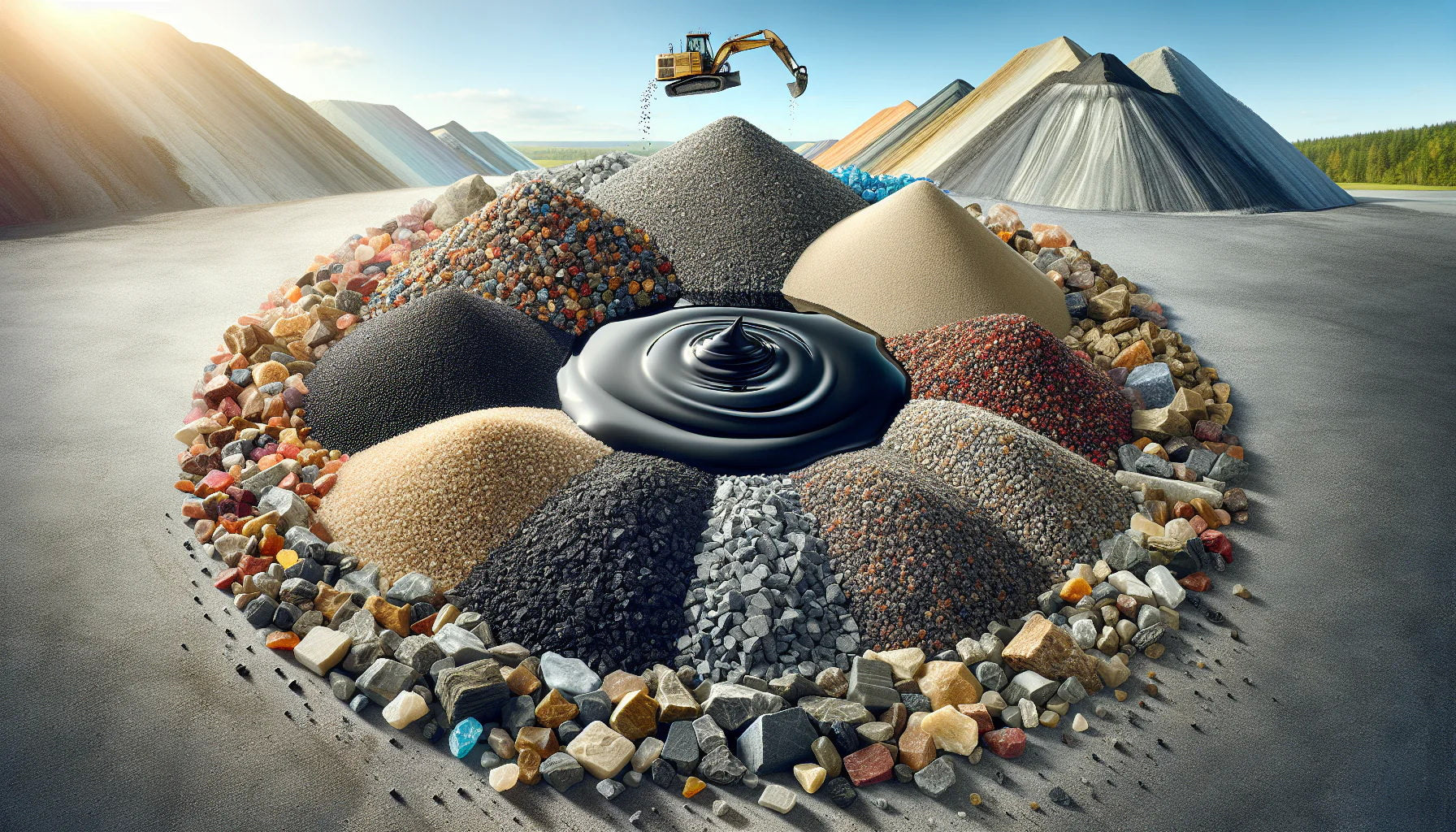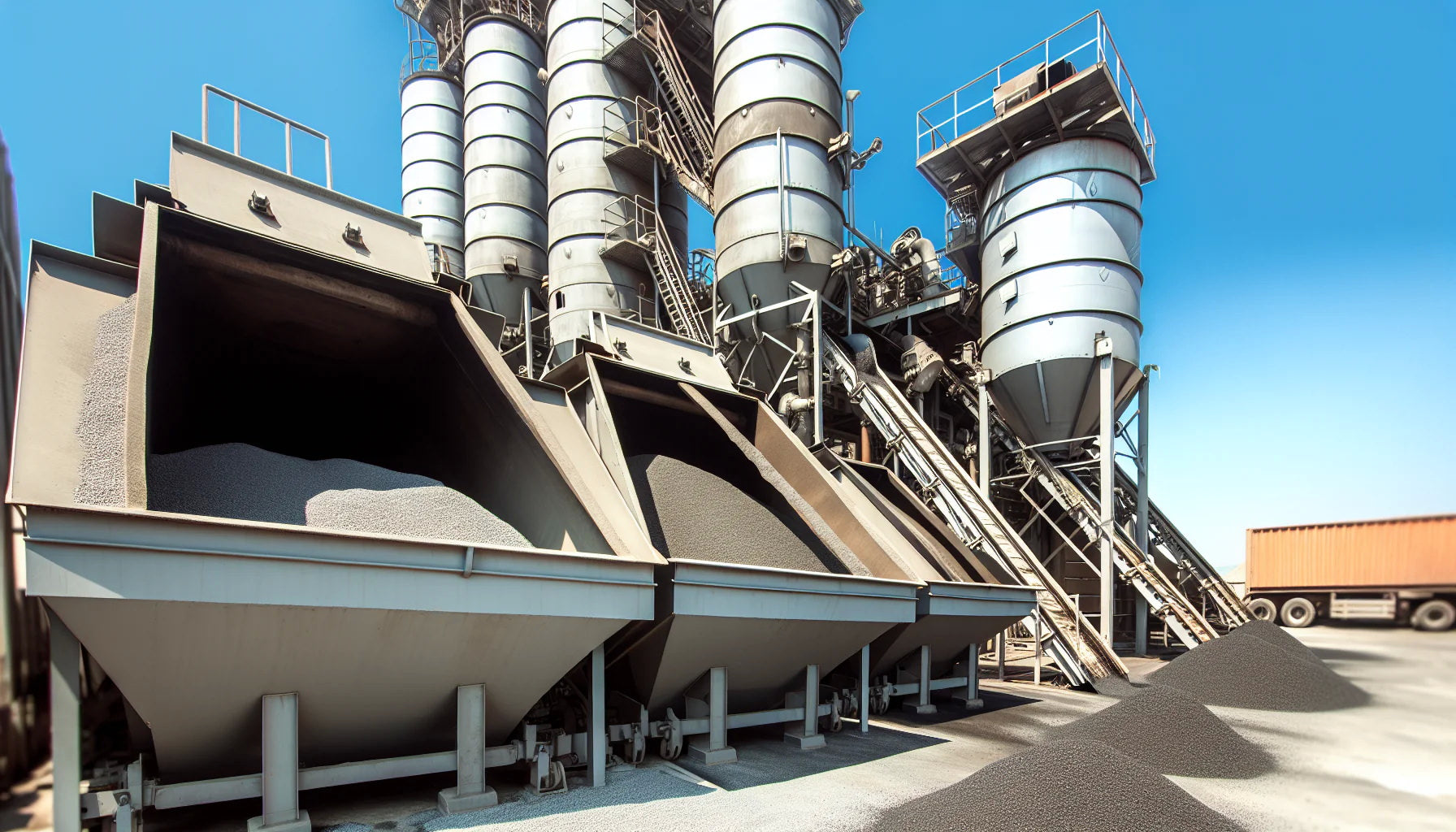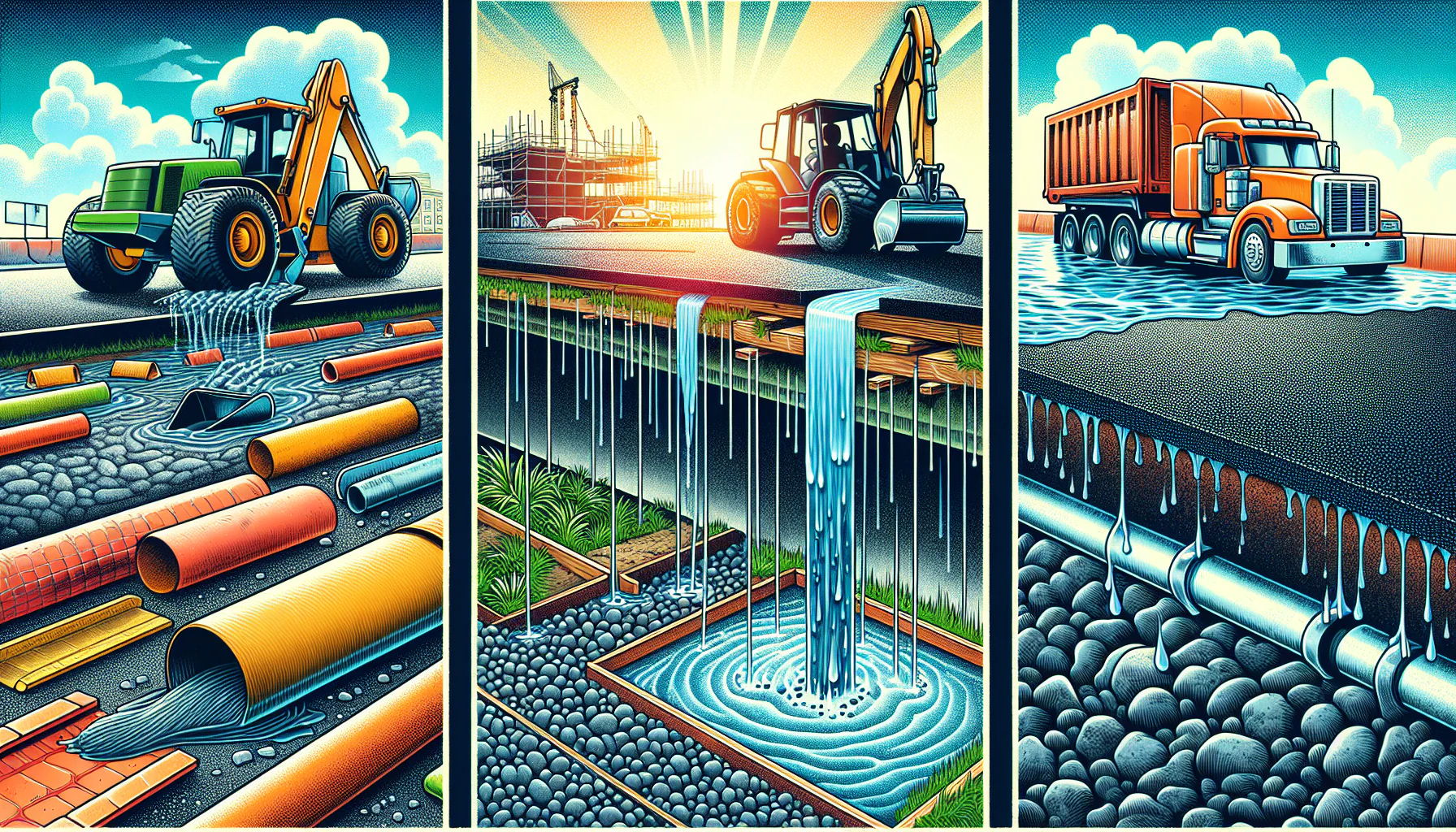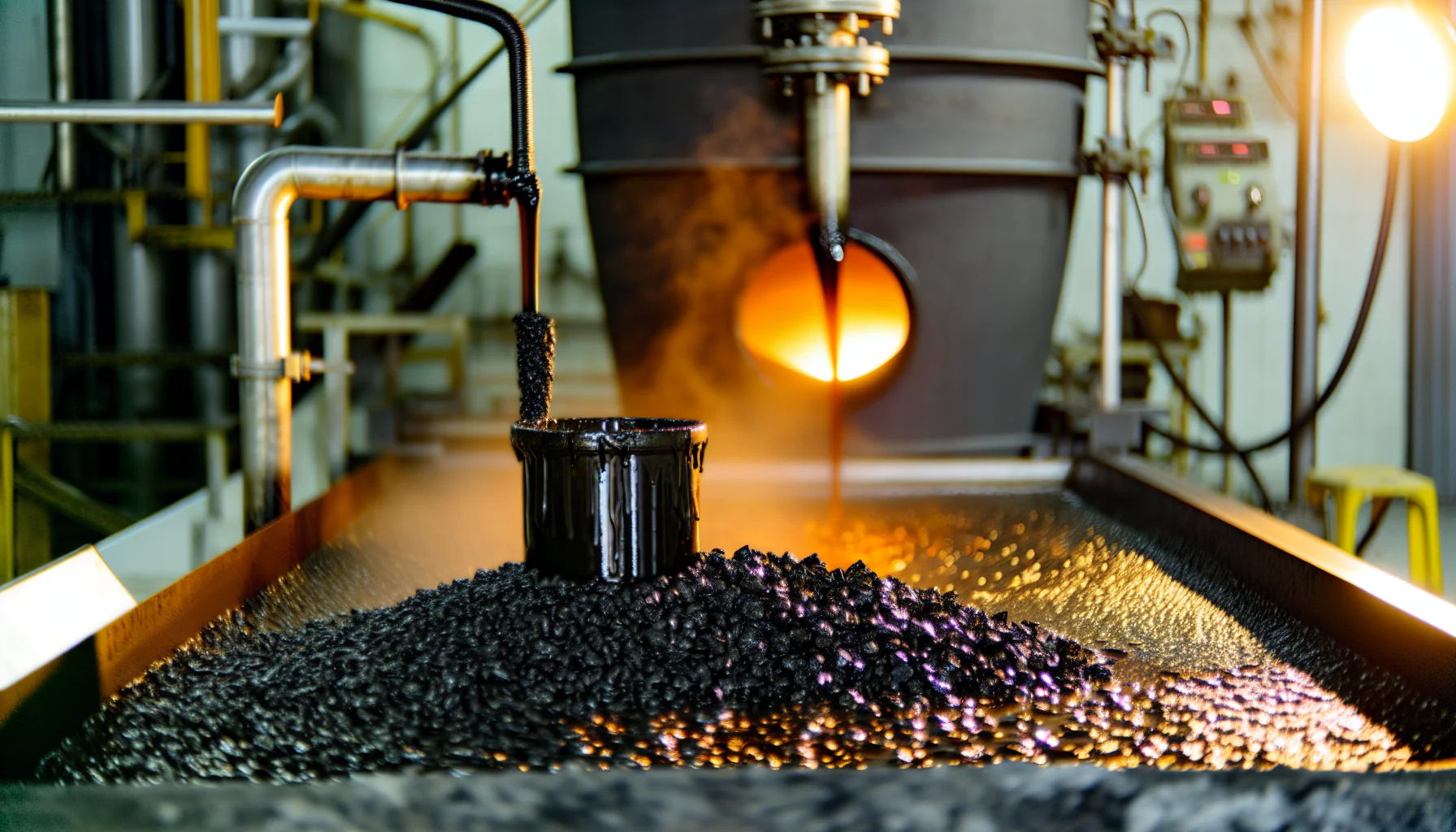What is Asphalt? Understanding Asphalt and Its Fundamental Components
Asphalt, the blacktop we drive on every day, is more than just road surface. It’s a carefully engineered material composed of aggregates like stone and sand, held together by bitumen—a tar-like byproduct of petroleum refining. Ever wonder what asphalt is and how these ingredients create the smooth roads under our wheels? Stay with us as we unpack the fascinating world of asphalt, its production, and its pivotal role in our day-to-day travel.
TLDR; Key Takeaways
- Asphalt predominantly consists of aggregates and bitumen, constituting 80% and 20% respectively, and is produced in different varieties like hot mix asphalt, warm mix asphalt, and cold mix asphalt, each tailored for specific conditions and uses.
- Demands of specific transportation and environmental conditions dictate the choice of asphalt types with hot mix asphalt being durable for high traffic, warm mix asphalt beneficial for energy savings and reduced pollution, and cold mix asphalt suitable for low-traffic repairs and temporary fixes.
- Asphalt pavement has a layered structure for strength and durability, requires regular maintenance such as crack filling and spraying sealcoat to prolong its life, and incorporates recycled materials to promote sustainability and cost-efficiency in road construction.
Defining Asphalt and Its Fundamental Components

Every road trip, morning jog, or bike ride begins with a single step or wheel rotation on an asphalt surface. But what exactly is this material that forms the backbone of our transportation infrastructure? In its simplest form, asphalt concrete, also known as hot mix asphalt, is a combination of aggregates, such as crushed stone, gravel, and sand, and bitumen, a sticky black petroleum-based substance. In fact, about 80% of the asphalt pavement consists of these aggregates, while bitumen makes up the remaining 20%, serving as the glue that holds everything together.
Despite its ubiquitous presence in our daily lives, the exact composition and manufacturing process of asphalt remain a mystery to many. Therefore, it’s enlightening to examine the fundamental principles of asphalt production and its diverse applications.
The Birthplace of Asphalt: Inside the Asphalt Plant

The journey of asphalt starts in a bustling environment called the asphalt plant. This facility features key components such as:
- Cold aggregate feeder bins
- A drying drum with a burner
- Dust collectors
- A tower unit with a bucket elevator
- Screening units
- Storage silos
It’s here where raw aggregates are dried and heated in a drum, transferred, screened by size, and stored in hot bins within the tower unit.
The magic happens in the mixing unit, where precisely weighed aggregates are combined with heated bitumen and filler to form the asphalt mix. This intricate dance of materials, managed and controlled by a dedicated operator through a control panel, ensures high-quality mixtures through accurate batching processes.
We will now explore different asphalt mixtures that these plants produce.
Hot Mix Asphalt (HMA): The High-Performance Pavement
First on the list is Hot Mix Asphalt (HMA), the Hercules of asphalt types. Produced under high heat, HMA is the most durable of the asphalt types, capable of withstanding varying weather conditions and heavy traffic. This robustness and longevity are ensured by the high production temperatures of between 150 and 180 degrees Celsius.
HMA’s strength and resilience make it the most commonly used type on roads and pavements, particularly in areas subject to high traffic. The secret to its high-traffic application lies in the heating of both asphalt and aggregate before mixing, a process that distinguishes it from the production of cold mix asphalt. Moreover, the incorporation of recycled asphalt shingles into the HMA formulation is not only cost-effective but environmentally beneficial as well, as it decreases reliance on raw mined materials while enhancing pavement quality.
Warm Mix Asphalt (WMA): Eco-Friendly Paving Solutions
Next up is Warm Mix Asphalt (WMA), the eco-friendly cousin of HMA. Unlike its relative, WMA utilizes lower production temperatures, leading to significant benefits.
- Energy savings
- Reduction in the carbon footprint of asphalt paving operations
- Fuel consumption reduced by approximately 20%
- Decrease in the production of greenhouse gases by lowering the heating temperature of the asphalt mix
But the benefits of WMA go beyond environmental savings. Workers also benefit from an improved work environment due to the lower levels of fuel emissions, fumes, and odors when WMA is produced and applied. It’s worth noting that WMA is not a separate asphalt type per se, but rather a method of producing traditional asphalt mixtures at 20 to 40°C lower temperatures than typical hot mix asphalt.
Cold Mix Asphalt: The Quick Fix for Potholes
Cold Mix Asphalt (CMA) stands out as a particularly noteworthy material. It is manufactured by blending aggregates with emulsified or foamed bitumen at room temperature, eliminating the need to heat the aggregate. This characteristic renders the production of CMA more cost-effective and environmentally friendly, making it an excellent choice for minor construction projects and repairs, especially in remote locations where infrastructure may not be as advanced.
Ideal for small-scale maintenance tasks such as filling potholes, cold patch asphalt proves especially useful in less-trafficked rural areas and roads. It serves well for provisional patching work too, which can then be reapplied if necessary. In contrast to hot mix asphalt though, Cold Mix Asphalt takes longer to cure because its strength development relies on water evaporation from the emulsion and recovery of binder properties. To improve pliability when temperatures drop, low volatile substances are sometimes mixed into the asphalt. These elements eventually evaporate after application leaving behind only solid repair materials.
Asphalt Types and Their Specific Uses

Beyond the three main variants produced in asphalt plants, there are other unique types of asphalt each tailored for specific purposes. For instance, there’s mastic asphalt, known for its high durability and waterproofing properties. This makes it an excellent choice for road construction and roofing applications. Its pliability and strong bond with the underlying material also make it effective for repairing wide cracks and potholes.
We also have dense-graded asphalt mixes, versatile materials that provide durability for any pavement layer and traffic conditions, protecting against cracks and potholes. Then there’s porous asphalt, a unique product that allows water to drain through the pavement, making it ideal for managing stormwater in areas such as parking lots, driveways, playgrounds, and sidewalks.
Warm mix asphalt, with its versatility, can be utilized in a variety of pavement types including dense-graded, stone matrix, porous, and mastic asphalt for an array of applications.
The Layered Approach: How Asphalt Pavement Consists of Multiple Layers
Peering beneath the asphalt surface, one can discover a layered structure reminiscent of a delectable lasagna. First, there’s the surface layer, also known as the wearing course. This layer is designed to provide a smooth riding surface and skid resistance, ensuring an even profile for user comfort, safety, and longevity.
Digging deeper, we find the binder course, serving as the intermediate layer. This layer consists of large aggregate mixed with oil, providing structural strength and preventing deformation, low-temperature cracking, and water intrusion.
At the base, we find the base course, acting as the foundation for the surface layers, critical in supporting traffic loads and minimizing strain and fatigue cracking. Each of these layers is designed based on its expected stresses, with top layers typically subjected to compressive stress and bottom layers to tensile stress.
The Lifecycle of an Asphalt Surface
Depending on factors such as installation quality, local climate, and traffic volume, an asphalt surface can last anywhere from 12 to 35 years. This durability is influenced by several factors, including:
- The presence of moisture
- Temperature shifts
- Traffic intensity
- Chemical exposures
Regular maintenance activities, including crack filling and pothole repair, are vital to prolong the life of an asphalt surface. These activities help to preserve asphalt surfaces against environmental factors like UV rays and temperature extremes. In fact, timely maintenance can result in cost efficiency by slowing the deterioration rate of asphalt surfaces, thus avoiding more frequent and elaborate repairs.
Crack Filling Techniques
Just as wrinkles are a certainty on one’s face, so too are cracks on asphalt pavement—an unavoidable occurrence that can be kept under control. By consistently examining the asphalt surfaces, especially when faced with extreme weather conditions, small damages can be spotted and addressed early on to halt their progression. It is essential in preventative maintenance to fill minor fissures promptly in order to prolong the life of the pavement and ward off water penetration.
When addressing cracks that exceed 2 inches in depth, it is recommended to first lay down a base of compacted sand or finely crushed gravel prior to employing a crack filler like an asphalt repair product. This preparation ensures thorough filling and creates a barrier against water seepage which could exacerbate damage over time.
Sealcoating for Protection
Just as our skin benefits from a moisturizer to ward off the effects of extreme weather, asphalt surfaces also require protection. Sealcoating plays a crucial role in maintaining the integrity of surfaces paved with asphalt by providing a protective barrier against various destructive elements. When applied, the asphalt sealer material offers a resilient and waterproof layer that shields asphalt from the harm caused by water, fuel spills, oil leaks, and ultraviolet light—each contributing to premature wear and tear.
The process of applying sealcoat on an asphalt surface can be done effectively using either a spray system or squeegee method. It usually sets within three to four hours after application. To ensure ongoing defense for your asphalt surfaces, it’s advised to reapply sealcoating every two or three years. This frequency may vary depending on how much traffic they bear and their exposure to different environmental factors.
From Crude Oil to Your Driveway: The Asphalt Making Process

The transition from crude oil to your driveway is a captivating journey. It starts with the distillation of crude oil, where it is rapidly heated and lighter fractions are removed. The heavy deposit left, called ‘topped’ crude, can be processed to make asphalt. The asphalt mixture is then heated to around 300 degrees Fahrenheit to properly combine the materials, with the correct quantity of bitumen critical for the desired consistency and durability of the asphalt.
After the asphalt is laid, transitions and joints are created for smooth connections. Finally, a final roll is conducted to compact the surface for a finished appearance.
This intricate process, from the distillation of crude oil to the heating and mixing of aggregates and bitumen, culminates in a durable and flexible material that forms the backbone of our transportation infrastructure.
The Role of Recycled Materials in Modern Asphalt Production
 Asphalt production doesn’t solely focus on new materials; it also breathes new life into old materials. Asphalt pavement is America’s most recycled material, with approximately 100 million tons reclaimed each year, and about 95% of that is reused in road construction. This reduces the need for new oil, conserves natural resources, and minimizes waste sent to landfills. The use of natural asphalt in the process further contributes to the sustainability of this industry.
Asphalt production doesn’t solely focus on new materials; it also breathes new life into old materials. Asphalt pavement is America’s most recycled material, with approximately 100 million tons reclaimed each year, and about 95% of that is reused in road construction. This reduces the need for new oil, conserves natural resources, and minimizes waste sent to landfills. The use of natural asphalt in the process further contributes to the sustainability of this industry.
Special measures, such as hot recycling technology and asphalt pulverization, allow eco-friendly asphalt plants to use reclaimed asphalt pavement effectively, saving materials and reducing environmental impact. The adoption of asphalt recycling leads to economic benefits including cost savings for taxpayers and contractors, as well as reduced costs associated with energy, materials, and transportation. However, despite the positive attributes of recycled materials in asphalt production, the use of Cold Mix Asphalt (CMA) has been limited due to its stability and durability issues, with ongoing research aimed at improving its performance.
Maintaining the Integrity of Your Asphalt Pavement
Just as keeping a car in prime working condition requires regular checks and timely fixes, maintaining the integrity of your asphalt pavement follows a similar principle. Regular inspections of asphalt pavement, especially during extreme weather conditions, can identify minor damages early and prevent them from escalating. Repairing cracks swiftly is crucial to stop them from expanding and leading to further pavement degradation.
However, maintenance extends beyond just fixing cracks. Removing stains from substances such as gasoline or oil is vital because they can dissolve the asphalt surface, resulting in degradation over time. Furthermore, maintaining proper drainage is essential for preserving the structural integrity of an asphalt pavement, as standing water can cause serious damage.
Regular cleaning of the asphalt surface, including monthly or more frequent cleaning in high traffic areas, helps to remove damaging debris and prevent stains from environmental materials.
Kevin King's Expert Insights on Asphalt Quality and Maintenance
In the realm of asphalt quality and maintenance, Kevin King’s voice stands out. As the founder and primary contributor at Asphalt Industrial, he possesses significant experience in the asphalt maintenance industry, which establishes his credibility. Through collaboration with leading manufacturers like Asphalt Kingdom, he underscores the importance of high-quality products in achieving consistent and reliable asphalt mixes.
Kevin doesn’t just focus on asphalt quality – he also shares practical advice on maintaining asphalt. Drawing from his expertise, King provides recommendations on techniques and selecting the best maintenance equipment. Believing in the potential for business success in the asphalt industry, King champions the power of the right guidance and tools to foster business growth.
Summary
To sum up, asphalt’s realm is considerably more intricate and enthralling than it initially seems. The transition of basic ingredients through advanced technological methods into asphalt illustrates the resourcefulness of humankind in converting natural materials into robust and lasting infrastructure. Regardless if you are a road engineer, urban designer, or simply an inquisitive individual, grasping the complex composition of asphalt, its life span and the significance of consistent upkeep can deepen your recognition for the thoroughfares that weave our daily connections together.
Frequently Asked Questions
What is asphalt basically used for?
Primarily utilized in the construction of roadways and highways, asphalt also serves functions in waterproofing, sealing, and insulation materials. This substance comprises an aggregate amalgamated with a binder to form what is known as asphalt cement.
Is asphalt the same as blacktop?
To summarize, while both materials are similar, asphalt and blacktop differ in usage. Asphalt is commonly applied to construct major roadways and streets due to its durability under heavy use. Conversely, blacktop is a type of asphalt designed for areas with less traffic such as driveways, parking lots, and playgrounds where the demand on the surface is not as intense. Lear more about blacktop vs asphalt here.
Why is asphalt better than concrete?
Asphalt is favored over concrete due to its cost-efficiency, faster installation process, and lower maintenance needs. Although concrete may last longer, for smaller projects or when budget constraints are a concern, asphalt becomes the preferred option. Read more about the differences of concrete vs. asphalt here.
What is natural asphalt made of?
Natural asphalt forms over a span of more than 70 million years as Anacacho limestone is saturated with a concentrated bitumen binder through intense heat and pressure, creating an effective material for paving. Read about asphalt binder vs top coat asphalt here.
It’s thought that this transformation happens when organic marine deposits decompose into petroleum during the process.
What are the types of asphalt?
Asphalt types encompass Hot Mix Asphalt (HMA), Warm Mix Asphalt (WMA), Cold Mix Asphalt (CMA), and specialized varieties such as mastic asphalt, dense-graded asphalt, and porous asphalt.


